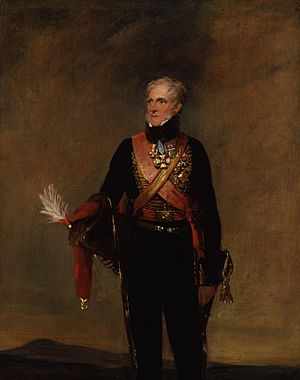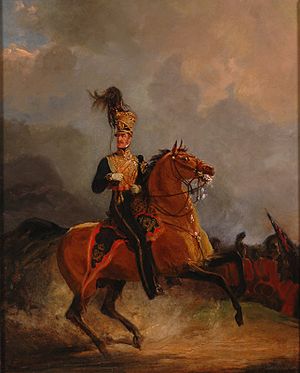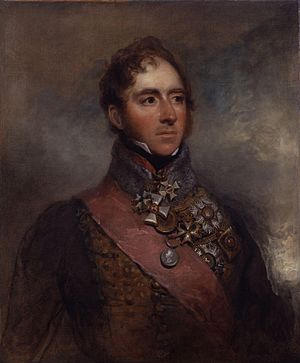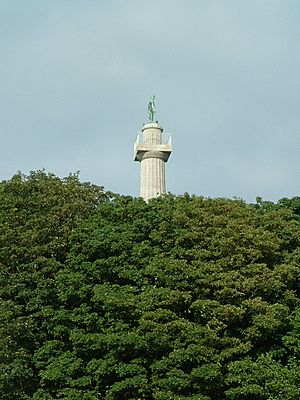Henry Paget, 1st Marquess of Anglesey facts for kids
Quick facts for kids
Field Marshal The Most Honourable
The Marquess of Anglesey
|
|
|---|---|
 |
|
| Lord Lieutenant of Ireland | |
| In office 27 February 1828 – 22 January 1829 |
|
| Monarch | George IV |
| Prime Minister | The Duke of Wellington |
| Preceded by | The Marquess Wellesley |
| Succeeded by | The Duke of Northumberland |
| In office 4 December 1830 – 12 September 1833 |
|
| Monarch | William IV |
| Prime Minister | The Earl Grey |
| Preceded by | The Duke of Northumberland |
| Succeeded by | The Marquess Wellesley |
| Personal details | |
| Born |
Henry William Bayley
17 May 1768 London |
| Died | 29 April 1854 (aged 85) Uxbridge House, London |
| Resting place | Lichfield Cathedral |
| Nationality | British |
| Political party | Whig Tory |
| Spouses | |
| Children | 18 |
| Parents |
|
| Alma mater | Christ Church, Oxford |
| Military service | |
| Allegiance | United Kingdom |
| Branch/service | British Army |
| Years of service | 1793–1854 |
| Rank | Field Marshal |
| Commands | 7th Light Dragoons |
| Battles/wars | French Revolutionary Wars |
| Awards | Knight of the Order of the Garter Knight Grand Cross of the Order of the Bath Knight Grand Cross of the Royal Guelphic Order |
Henry William Paget, 1st Marquess of Anglesey (17 May 1768 – 29 April 1854) was a brave British Army officer and an important politician. He was known for his amazing cavalry skills in battles like the Peninsular War and the famous Battle of Waterloo. At Waterloo, he lost part of his leg but continued to serve his country. He also held significant political roles, including being the Lord Lieutenant of Ireland twice.
Contents
Early Life and Political Beginnings
Henry William Paget was born Henry Bayley in London. His father was Henry Bayley-Paget, who later became the 1st Earl of Uxbridge. His mother was Jane Champagné. In 1770, his father changed the family name to Paget.
Henry went to Westminster School and then to Christ Church, Oxford for his education. After his studies, he became a member of parliament. He represented different areas like Carnarvon and Milborne Port. He served in parliament from 1790 until 1810, with a few breaks.
Military Career and Cavalry Leadership
Henry Paget began his military career during the French Revolutionary Wars. In 1793, he helped create a group of volunteers from Staffordshire. This group became the 80th Regiment of Foot.
He quickly rose through the ranks in the British Army. By 1797, he was in charge of the 7th Light Dragoons, a cavalry unit. He led his cavalry in battles during the Anglo-Russian invasion of Holland in 1799.
Fighting in Spain
Paget became a major-general in 1802. He led the cavalry for Sir John Moore's army in Spain during the Peninsular War. His cavalry was very successful against the French.
- At the Battle of Sahagún in 1808, his cavalry captured French officers. They also badly damaged a French cavalry unit.
- Later, at the Battle of Benavente, he defeated the best French cavalry, the Imperial Guard.
- He also led the cavalry during the difficult retreat to Corunna in 1809.
After 1809, he did not serve in the Peninsular War anymore. He did take part in the Walcheren Campaign in 1809, leading an infantry division. In 1812, he inherited the title of Earl of Uxbridge when his father passed away.
The Battle of Waterloo
During the Hundred Days in 1815, Henry Paget was put in charge of the cavalry in Belgium. He served under Wellington.
He fought bravely at the Battle of Quatre Bras on June 16, 1815. Two days later, he was a key figure at the famous Battle of Waterloo. There, he led a powerful charge of British heavy cavalry. This charge helped stop and break apart a large French army column.
Losing a Leg
Near the end of the Battle of Waterloo, a cannonball hit Paget's right leg. This meant his leg had to be removed. He famously joked about it, saying he had been "a beau these 47 years" and it was time for younger men to shine.
His artificial leg, which had movable joints, became known as an 'Anglesey leg'. He helped make this type of prosthetic leg popular. He was also sometimes called 'One-Leg' after this injury.
After the battle, on July 4, 1815, he was given the title of Marquess of Anglesey for his bravery. A tall monument was built in his honor in Llanfairpwllgwyngyll, Anglesey, in 1816. He also became a Knight of the Garter in 1818 and a full general in 1819.
Later Public Service

Even after losing his leg, Paget continued to serve his country. In 1821, he was the Lord High Steward of England at the coronation of King George IV.
In 1827, he joined the government as Master-General of the Ordnance. This role involved managing military supplies.
Lord Lieutenant of Ireland
He served twice as the Lord Lieutenant of Ireland. This was a very important position, like being the King's representative in Ireland.
- His first term was from 1828 to 1829.
- His second term was from 1830 to 1833. During this time, he helped introduce state-funded education for many children in Ireland.
He was still a skilled horseman, even with his artificial leg. Crowds would cheer for him as he rode through London. In 1846, he became Master-General of the Ordnance again. He was promoted to field-marshal in 1846. He retired from government in 1852.
Henry William Paget died on April 29, 1854, at his home in London. He was buried at Lichfield Cathedral. A monument was built there to honor him. His eldest son, Henry, took over his title.
Family Life
Henry William Paget was married twice and had many children.
His first marriage was to Lady Caroline Elizabeth Villiers in 1795. They had eight children together:
- Lady Caroline Paget (1796–1874)
- Henry Paget, 2nd Marquess of Anglesey (1797–1869)
- Lady Jane Paget (1798–1876)
- Lady Georgina Paget (1800–1875)
- Lady Augusta Paget (1802–1872)
- Lord William Paget (1803–1873)
- Lady Agnes Paget (1804–1845)
- Lord Arthur Paget (1805–1825)
In 1810, he married Lady Charlotte Cadogan. They had ten children, with seven surviving childhood:
- Lady Emily Paget (1810–1893)
- Lord Clarence Paget (1811–1895)
- Lady Mary Paget (1812–1859)
- Lord Alfred Paget (1816–1888)
- Lord George Paget (1818–1880)
- Lady Adelaide Paget (1820–1890)
- Lord Albert Paget (1821–1822)
- Lord Albert Paget (1823–died in infancy)
- Lady Eleanor Paget (1825–died in infancy)
Images for kids






